Great Offensive
The Great Offensive (Turkish: Büyük Taarruz) was the largest and final military operation of the Turkish War of Independence, fought between the Turkish Armed Forces loyal to the government of the Grand National Assembly of Turkey, and the Kingdom of Greece, ending the Greco-Turkish War. The offensive began on 26 August 1922 with the Battle of Dumlupınar. The Turks amassed around 104,000 men, the largest number since the beginning of the war, to begin the offensive against the Greek army of approximately 130,000 men.[10][11] From 31 August to 9 September, the front moved a distance of 300 km (190 mi) as the Greek troops retreated.[12] The Turkish army lacked motorized vehicles; its forces consisted of infantry and cavalry units, and logistical support was provided by a supply system based on ox carts.[13]
| The Great Offensive | |||||||||
|---|---|---|---|---|---|---|---|---|---|
| Part of the Greco-Turkish War (1919–22) of the Turkish War of Independence | |||||||||
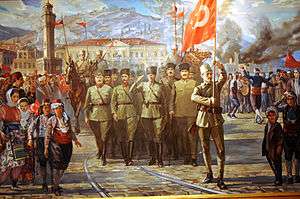 Entry of Turkish army into Izmir (Painting at War of Independence Museum) | |||||||||
| |||||||||
| Belligerents | |||||||||
|
|
| ||||||||
| Commanders and leaders | |||||||||
|
|
| ||||||||
| Strength | |||||||||
|
98,670 - 103,000 infantry 5,286 cavalry 323 artillery [1][2][3][4] |
130,000 infantry 1,300 cavalry 348 artillery [1][2][3][4] | ||||||||
| Casualties and losses | |||||||||
|
2,318 killed, 9,360 wounded, 1,697 missing and 101 prisoners Total: 13,476[5] |
By 7 September: 35,000 killed and wounded, 15,000 prisoners Total: 50,000[6][7][8][9] | ||||||||
The Turkish troops reached the sea on 9 September with the recapture of İzmir. The operation ended on 18 September 1922 with the liberation of Erdek and Biga. The staggering defeat caused great dissent within the Greek army and a general loss of morale, which led to unwillingness to continue fighting. On top of this, numerous Greek divisions had been encircled and destroyed as effective fighting units, which meant that the Greek army had lost its offensive capabilities and was unable to organize a controlled retreat, leading to numerous Greek POWs.
Advance
The offensive started with the Battle of Dumlupınar, where the Turkish army defeated the Greek army within four days, paving the way for a rapid offensive. After Mustafa Kemal Atatürk's order issued in the Forces of the Grand National Assembly of Turkey, the main part of the Turkish Army began moving toward İzmir and a secondary force began moving from Eskişehir toward Bursa.[14] On 7 September, Aydın, Germencik and Kuşadası fell under Turkish control. On 16 September, the last Greek troops left Çeşme, and two days later the Greek III Corps left Erdek. The British Chief of Staff expressed his admiration for the Turkish military operation.[15]
Gallery
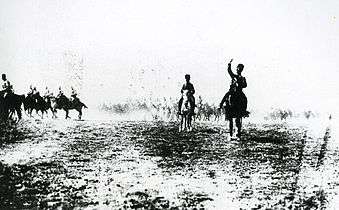 Turkish cavalry during a mopping-up operation
Turkish cavalry during a mopping-up operation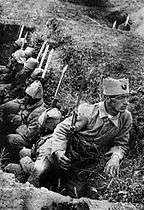 Turkish infantry in a trench
Turkish infantry in a trench Fahrettin Altay and V Cavalry Corps officers
Fahrettin Altay and V Cavalry Corps officers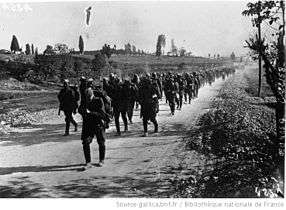 Greek soldiers retreating
Greek soldiers retreating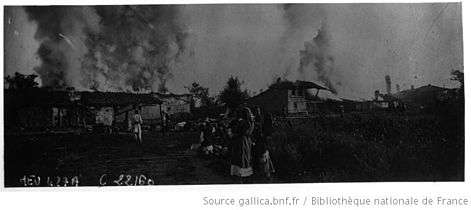 A Turkish village burnt by retreating Greek troops
A Turkish village burnt by retreating Greek troops- Inspection of the burned town of Turgutlu by a group of dignitaries and journalists
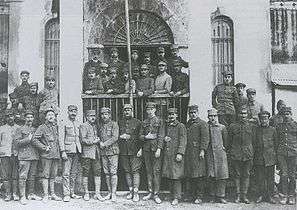 Greek POW officers in Ankara
Greek POW officers in Ankara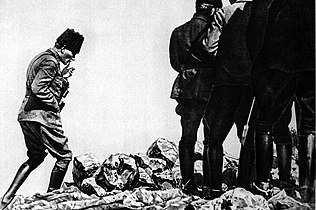 Mustafa Kemal Pasha at Kocatepe hill, Afyonkarahisar
Mustafa Kemal Pasha at Kocatepe hill, Afyonkarahisar
See also
- List of high-ranking commanders of the Turkish War of Independence
- Occupation of Smyrna
- Great Fire of Smyrna
References
- Belgelerle Türk tarihi dergisi, Editions 28–31, Menteş Kitabevi, 1999, page 35 (in Turkish)
- A. Dural: His Story: Mustafa Kemal and Turkish Revolution, ISBN 0595412513, iUniverse, 2007, page 93
- Nizamettin Nazif Tepedelenlioğlu: Bilinmiyen taraflariyle Atutürk, Yeni Çığır Kitabevi, 1959, page 64 (in Turkish)
- Assertion of unitary, independent national states in central and southeast europe (1821–1923), Bibliotheca historica romaniae Edition 62, Edited by Viorica Moisuc and Ion Calafeteanu, Section des sciences historiques de l'Académie de la République Populaire Roumaine., 1980, page 340 (footnote 94)
- Ali Çimen, Göknur Göğebakan: Tarihi Değiştiren Savaşlar, 2. Edition, ISBN 9752634869, page 321. (in Turkish)
- Armistice sought by Greeks as Turks press near Smyrna, New York Times, published 8 September 1922
- Clodfelter, Micheal. Warfare and armed conflicts : a statistical encyclopedia of casualty and other figures, 1492/2015 (Fourth ed.). p. 346. ISBN 1476625859.
- Chronicling America - Historic American Newspapers, Turk Cavalry Routs Greeks, The Ogden standard-examiner (Ogden, Utah), 7 September 1922, page 2.
- Armistice Sought By Greeks As Turks Press 8 September 1922.
- Bruce Clark: Twice a Stranger: The Mass Expulsions That Forged Modern Greece And Turkey, Harvard University Press, 2006, ISBN 0674023684, page 22.
- International Committee of Historical Sciences, 1980, page 227.
- International Committee of Historical Sciences. 1980, page 227.
- International Committee of Historical Sciences, 1980, page 227.
- International Committee of Historical Sciences. Commission of comparative military history, Revue internationale d'histoire militaire (Editions 46–48), University of Michigan, 1980, page 227.
- Elisabeth Özdalga: The Last Dragoman: The Swedish Orientalist Johannes Kolmodin as Scholar, Activist and Diplomat, Swedish Research Institute in Istanbul, 2006, ISBN 9789186884147, page 62.
Footnotes
Bibliography
- Kemal Niş, Reşat Söker, Türk İstiklâl Harbi, Batı Cephesi, Büyük Taarruz’da Takip Harekâtı (31 Ağustos – 18 Eylül 1922), Cilt 2, Kısım. 6, 3. Kitap, Genkurmay Başkanlığı Basımevi, Ankara, 1969. (in Turkish)
- İsmet Görgülü, Büyük Taarruz: 70 nci Yıl Armağanı, Genelkurmay Başkanlığı Basımevi, Ankara, 1992. (in Turkish)
- Celal Erikan, Komutan Atatürk, Cilt I-II, Üçüncü Basım, Türkiye İş Bankası Kültür Yayınları, İstanbul, 2001, ISBN 975-458-288-2. (in Turkish)
External links
| Wikimedia Commons has media related to Great Offensive. |
- "9 Eylül 1922 İzmir'in Kurtuluşu" ("9 September 1922 Rebelation of İzmir"), Tarihten Kesitler, General Staff of the Republic of Turkey. (in Turkish)
- İzmir Marşı (Izmir March) (lyrics) in Google Videos. (in Turkish)